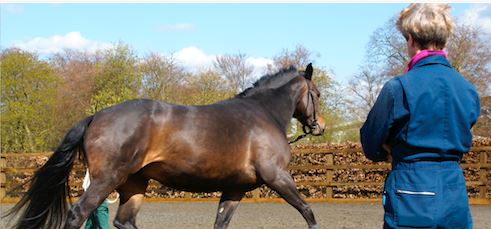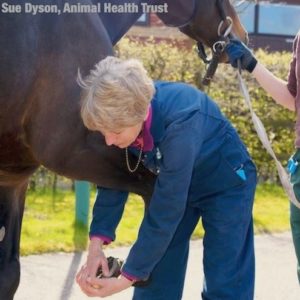Saddle Fit and Dr. Sue Dyson, MA, VetMB, PhD, DEO, FRCVS
I have never had the pleasure of meeting Dr. Sue Dyson in person, however, I very much appreciate her professional insights as a veterinarian regarding the necessity of proper saddle fit. She was a guest speaker at a recent National Equine Forum in the UK and is the veterinary advisor to the Saddle Research Trust, which was founded a few years ago by Anne Bondi. She will also be a guest speaker at the Florida Association of Equine Practitioners conference this October in Naples, FL. For me, she is one of the equine professionals whose philosophy on saddle fit is in total alignment with that of S4L. She absolutely ‘gets it’.


The National Equine Forum is a prestigious annual event, attended by leaders of their field within the equine industry, including vets, trainers, physiotherapists, farriers and welfare organisations. It is an opportunity for equine experts and enthusiasts to share their knowledge and research to improve the care and welfare of horses worldwide. I hope to be participating at a future conference on behalf of Saddlefit 4 Life®, but for this blog, I would like to briefly summarize some of the key points she made, since they underline what I have also found over the years.
At the NEF, Sue emphasised the importance of correct saddle fitting for the welfare of the horse, but also the implications on the rider’s position, balance and the pair’s potential to perform well together. Taking a holistic approach, saddle fitters should be encouraged to provide saddles that will not cause pain or compromise the horse’s musculoskeletal development and will also assist the rider to maintain a balanced position. Riders and trainers must also recognize the importance of good posture and harmonious movement to minimise inappropriate pressure points on the horse’s back.
Some Common Problems:
- Saddles are often fitted to the horse, but not to both the horse and rider. Riders are often found sitting in saddles too far back, or in saddles that are too small for them.
- If saddles are not fitted to the rider this can make them unbalanced and therefore place abnormal pressure on the horse’s back – I have often said that if the saddle doesn’t fit the rider, then it doesn’t matter how well it fits the horse; the rider’s discomfort will translate down and impede performance (plus could cause all sorts of health-related issues down the road!)
- Lameness and poor performance can be the result of an ill-fitting saddle, because the saddle may restrict the movement of the horse (as discussed many times in my “9 points of saddle fit”)
- Saddles are often not checked frequently enough for correct fit in horses that may change shape (e.g. young horses as they develop musculature through their training, or during seasonal weight changes). We continue to recommend at least once annually!
- Cost of tack can discourage owners from buying the ‘correct fit’, and instead they will purchase the ‘best fit’ from what is available. This can end up costing the owner/rider many times more $ because of possible health-related issues cropping up à chiropractic, physiotherapy, veterinary bills etc. Plus probably needing another new saddle in the near future as the horse continues to mature! Money invested in a correct-fitting saddle could save your horse’s back and a bill in the future due to the injuries an ill-fitting saddle could cause.
Our Common Call to Action:
- Better training and education available to saddlers, giving them access to the latest research and techniques to provide the best products for improved welfare and performance of the horse. (I suggest regulated and a common ‘language’ for saddle fitting globally – there are still too many ‘opinions’ out there that are not based on facts).
- Saddlers encouraged to consider the fit of tack to both the horse and the rider (Again – there are many saddlers who work in the industry who have never ridden or have had anything to do with horses, and certainly may not have even a basic understanding of equine conformation and anatomy [nor human] – this is something that needs to be addressed globally, as there are more and more ‘saddle fitting’ schools appearing every year. It is not necessarily the saddlers who need this additional education, but certainly saddle fitters should be required to undergo at least the basic certification)
- Owners reminded to have their tack checked when they change their horse’s routine, workload or type of training, and to consider the time of year and horse’s age or level of training to plan necessary saddle fit checks
- Basic rider position (shoulder-hip-heel alignment) emphasised to riders, trainers and saddle fitters from grass-roots level through to professionals, to better recognise poor saddle fit and promote good rider-horse balance (Many issues arise first from what is simply not good riding although no one likes to hear that. Even the best saddle fit to horse and rider will not be able to counteract this).
- Better owner education of how to check if your saddle fits – both Sue and Saddlefit 4 Life® have developed comprehensive checklists.
- Dr. Sue Dyson’s checklist: http://www.aht.org.uk/skins/Default/pdfs/saddle_guide.pdf
- Schleese checklist: https://schleese.com/2016/01/25/the-nine-points-of-saddle-fit/
By Jochen Schleese, CMS, CSFT, CSE (with information kindly provided by the Saddle Research Trust)
©2017 Saddlefit 4 Life® and SRT. All Rights Reserved
